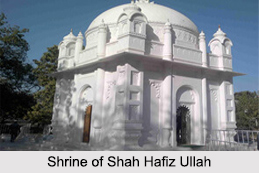 Shrine of Shah Hafiz Ullah is an architectural beauty of the Muslim period is located in Rajasthan. The shrine of Shah Hafiz Ullah is an example of the finest Islamic style of architecture. The shrine has been constructed on the south-west corner of Daman Kuh Masjid. This mosque was built to honour Shah Hafiz Ullah, who was considered to be a religious man in the late Mughal period. Shah Hafiz Ullah was also locally known as `Hafiz` or `Hafiz Dada`. He died on 26th Dhu`l Qa`da 1188/29 January 1775. According to an inscription found here, this shrine is believed to have been built in 1790 AD during the rule of Shah Alani.
Shrine of Shah Hafiz Ullah is an architectural beauty of the Muslim period is located in Rajasthan. The shrine of Shah Hafiz Ullah is an example of the finest Islamic style of architecture. The shrine has been constructed on the south-west corner of Daman Kuh Masjid. This mosque was built to honour Shah Hafiz Ullah, who was considered to be a religious man in the late Mughal period. Shah Hafiz Ullah was also locally known as `Hafiz` or `Hafiz Dada`. He died on 26th Dhu`l Qa`da 1188/29 January 1775. According to an inscription found here, this shrine is believed to have been built in 1790 AD during the rule of Shah Alani.
Architecture of Shrine of Shah Hafiz Ullah
The shrine of Shah Hafiz Ullah is a small square domed chamber. An arched porch has been constructed in front of the entrance at the eastern side. The shrine had been built after the death of Shah Hafiz Ullah. The corner portions of the shrine have been made in the form of circular piers. Each of the walls has two flat arched niches, one within the other. The porch has a flat roof and the chamber has a ribbed dome with a large finial of the Mughal period.
On the western side of the shrine a mosque of Shah Hafiz Ullah has been built. It comprises of a single prayer hall. On one side of the prayer hall a flat roof supported by the qibla wall has been constructed and on the other side a row of lobed arches has been built. An inscription has been engraved on the mihrab that states the date of the mosque on 21st Rabi II, 1204/8th January, 1790 during the reign of Shah Alani. Another small structure has been built on the northern side of the courtyard of the compound. The structure has been adorned with columns and arches that resemble the `Daman Kuh Masjid` another famous mosque in Rajasthan. On the southern side a square tomb has been built with a flattened dome.
This article is a stub. You can enrich by adding more information to it. Send your Write Up to content@indianetzone.com





















